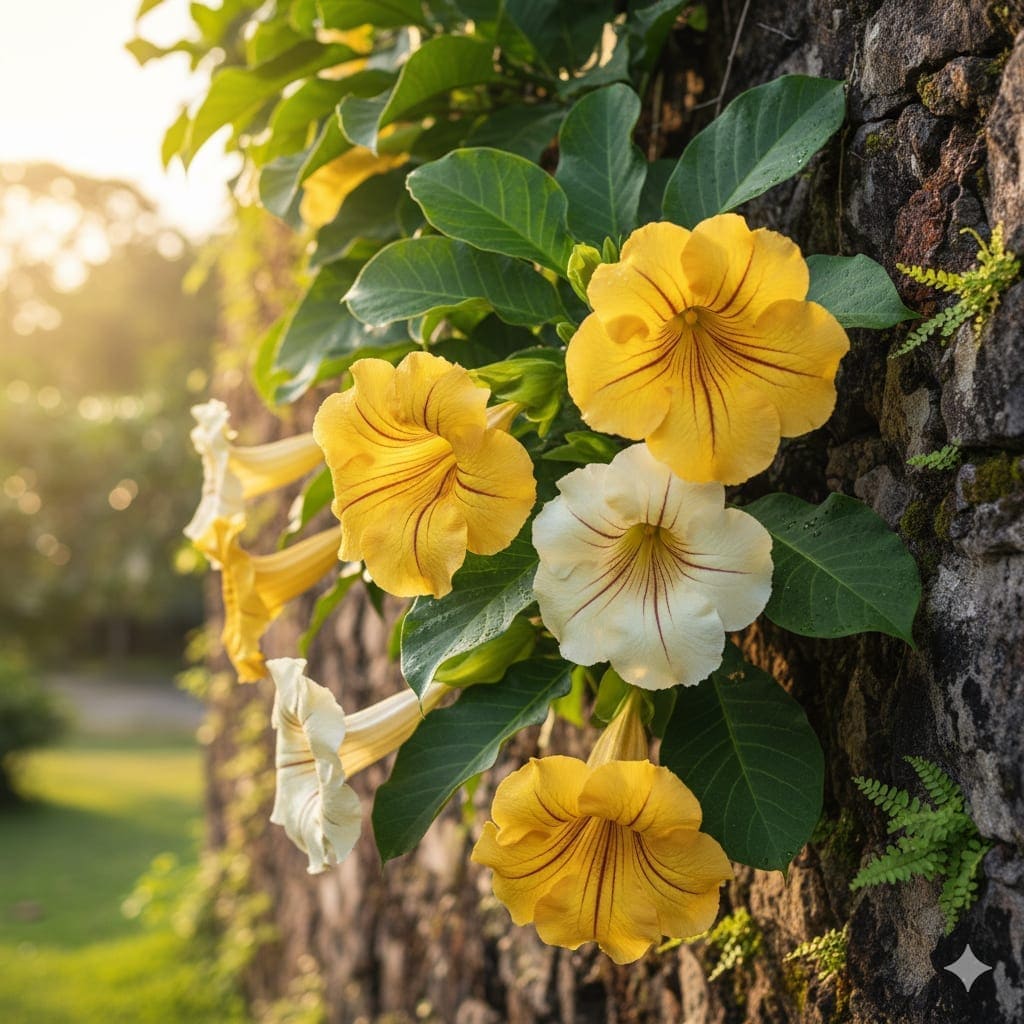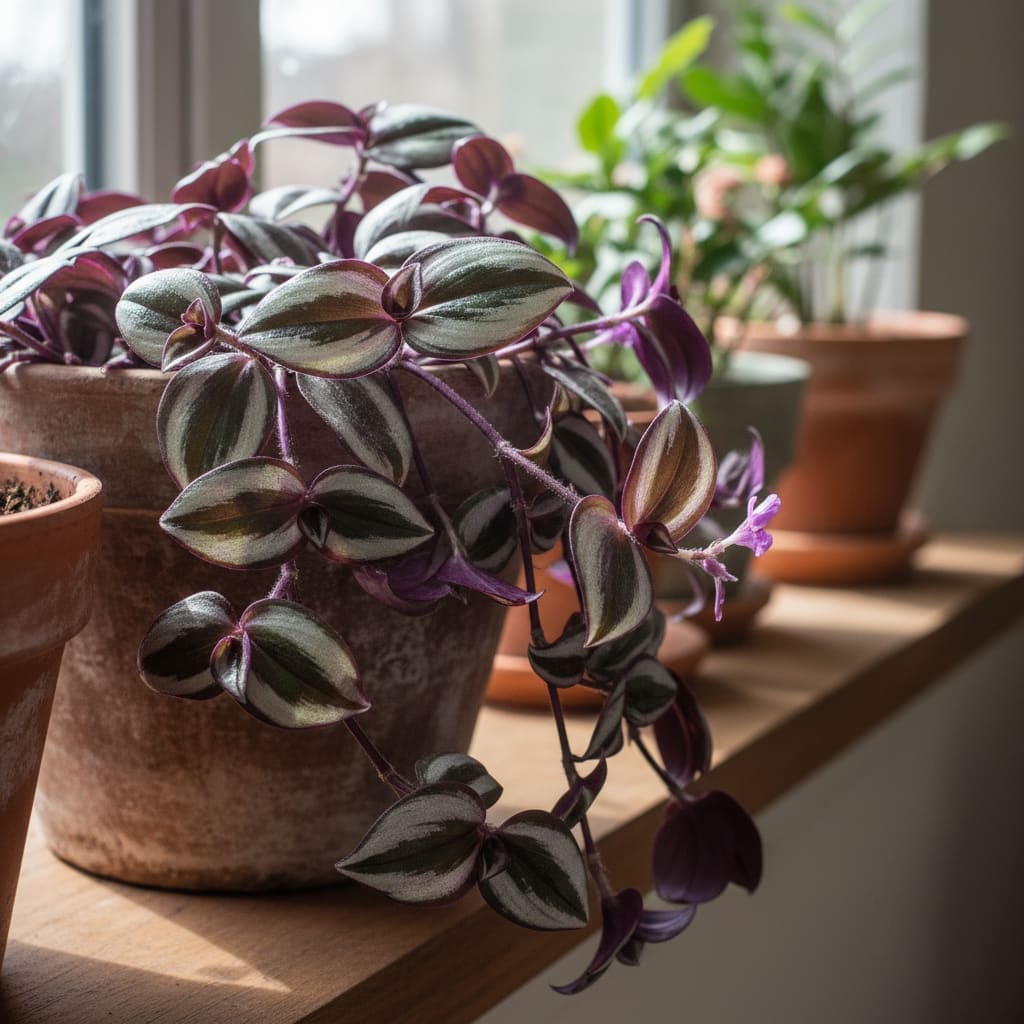Solandra maxima (Cup of Gold Vine) Care & Growing Guide
Overview
Solandra maxima, commonly known as the Cup of Gold Vine or Golden Chalice Vine, is a striking tropical climber native to Mexico and Central America. Known for its large, trumpet-shaped yellow flowers with a sweet, intoxicating evening fragrance, this plant is a favorite among gardeners seeking an exotic focal point. In its natural habitat, it can scramble over trees and structures, producing blooms that attract nocturnal pollinators such as moths.
When grown in cultivation, Solandra maxima can be trained as a climber on trellises, pergolas, or moss poles, or allowed to cascade from large containers. It is a vigorous grower in warm climates and can be kept indoors in cooler regions with proper care.
Identification & Growth Habit
Solandra maxima is an evergreen vine with leathery, glossy, deep green leaves that are elliptical to oblong in shape. Mature leaves can reach up to 15 cm (6 in) long. The plant’s most distinctive feature is its large, chalice-like flowers, which can be 15–20 cm (6–8 in) across. The blooms are golden yellow with purple-brown veins inside the throat and are most fragrant in the evening.
Its growth habit is vigorous and climbing, capable of reaching 12 meters (40 ft) or more outdoors in frost-free climates. Indoors or in containers, it can be pruned to a manageable size and trained to climb supports or trail over edges.
Light & Placement
Provide bright, indirect light for optimal growth. A location near an east- or south-facing window with filtered sunlight is ideal. While it can tolerate some direct sun, prolonged exposure to harsh midday rays can scorch the foliage. Outdoors, place it where it receives morning sun and afternoon shade in hot climates.
If grown indoors, rotate the plant periodically to encourage even growth and prevent it from leaning toward the light source.
Watering & Humidity
Water when the top 2–3 cm (about 1 inch) of soil feels dry to the touch. Solandra maxima prefers slightly dry conditions between waterings, so avoid letting it sit in waterlogged soil. Reduce watering in winter when growth slows.
Moderate to high humidity is preferred. In dry indoor environments, occasional misting, grouping plants together, or using a humidifier can help maintain adequate moisture in the air.
Soil & Repotting
Use a well-draining soil mix such as standard potting soil amended with perlite or coarse sand to improve aeration. Ensure the container has drainage holes to prevent root rot.
Repot every 2–3 years or when roots become crowded, ideally in spring before the active growing season. Choose a pot only slightly larger than the current one to avoid excessive soil moisture retention.
Fertilizing
Feed monthly during spring and summer with a balanced liquid fertilizer diluted to half strength. This supports healthy foliage and flower production. Reduce or stop feeding in autumn and winter when growth naturally slows.
Pruning & Training
Prune to control size, remove dead or damaged growth, and encourage branching. The best time to prune is after flowering. Solandra maxima responds well to training on a trellis, arbor, or moss pole. Tie stems gently to supports as they grow, guiding the vine’s direction.
For a bushier appearance, pinch out growing tips periodically to stimulate lateral shoots.
Propagation
Step-by-Step: Stem Cuttings
- Select a healthy, non-flowering stem and cut just below a node (where leaves attach).
- Remove the lower leaves, leaving 2–3 at the top.
- Optional: Dip the cut end in rooting hormone to encourage faster root development.
- Place the cutting in water or insert into a pot filled with moist, well-draining propagation mix.
- Keep in bright, indirect light and maintain consistent moisture (not soggy).
- Roots typically develop in several weeks; transplant to a larger pot once well established.
Common Problems
Pests
- Aphids: Small, sap-sucking insects that cluster on new growth. Remove with a strong spray of water or treat with insecticidal soap.
- Spider mites: Cause stippling and fine webbing on leaves. Increase humidity and use miticides if infestation is severe.
- Scale insects: Appear as small, brown bumps on stems and leaves. Remove manually or treat with horticultural oil.
Diseases
- Root rot: Caused by overwatering or poor drainage. Prevent by using well-draining soil and watering appropriately.
- Leaf spot: Fungal or bacterial spots on leaves. Remove affected foliage and improve air circulation.
Toxicity & Pet Safety
Warning: All parts of Solandra maxima are considered toxic if ingested by humans or animals. Keep out of reach of pets and children, and wear gloves when pruning if you have sensitive skin.
Styling & Decor Tips
Due to its bold foliage and large flowers, Solandra maxima works well as a statement plant in sunrooms, conservatories, or on sheltered patios. Train it over an archway or pergola for a dramatic floral display, or let it cascade from a large hanging container in climates where it can be overwintered indoors.
Varieties & Cultivars
While Solandra maxima is the most widely grown species in the genus, related species such as Solandra grandiflora and Solandra longiflora share similar characteristics but may differ slightly in flower size, shape, or vine vigor.
Buying Tips & Maturity
When purchasing, look for healthy plants with vibrant green leaves, no signs of pests, and sturdy stems. Avoid specimens with wilted or yellowing foliage. Younger plants may take a few years to produce their first flowers, especially if grown from cuttings. Mature, well-established vines are more likely to bloom prolifically.
Seasonal Care
- Spring: Resume regular feeding and watering; repot if necessary.
- Summer: Provide consistent moisture and support for vigorous growth; watch for pests.
- Autumn: Reduce feeding; prune after flowering to shape the plant.
- Winter: Protect from cold; move indoors if temperatures drop below 50°F (10°C); water sparingly.
FAQ
- How fast does Solandra maxima grow? In warm, bright conditions, it can grow rapidly, adding several feet of vine in a single season.
- When does it flower? In suitable climates, it typically blooms in late winter to early spring, though timing can vary.
- Can it be grown indoors year-round? Yes, if provided with bright, indirect light, adequate humidity, and support for climbing.
- Does it need a large container? A medium to large container with good drainage is recommended to accommodate its root system and support its top growth.
- Is it frost-hardy? No. It is sensitive to frost and should be protected or brought indoors in cold climates.






